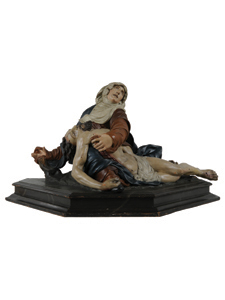Pieta (Hall 21)

One of the most representative pieces in the museum is this Pieta, executed around 1537 and attributed to sculptor Juan de Juni. It is the only work by this artist in a Catalan museum. Made of terracotta, the piece captures the moment when Mary holds the body of her dead son in her arms. The cross, which was made of the same wood as the base, has been lost.
The composition is charged with energy, with dynamic impulses shooting out in every direction. The figure's sinuous qualities showcase the artist's abilities and his knowledge of the mannerist theory involving multiple points of view. In a brazen move, the Virgin Mary makes an arching movement while seated on the ground. Her leg moves forward while her right arm stretches backward. The body of Christ weighs heavily on Mary's lap. His arms and legs are inert and his head falls back in a pathetic gesture. The faces of both mother and son transmit a deep sense of tragedy. The sculpture's diminutive scale suggests that it was originally made for a small chapel.
Juan de Juni was born in France (probably in Joigny). He took on the more Spanish version of his name later on. He was trained in Italy, where he first made contact with classical sculpture and the work of great artists from the first Renaissance. It was also while in Italy that he learned to work with clay, a malleable material that could be modeled with a high level of naturalism. Much of his work took place in León and Valladolid; he is considered one of the key figures of the Spanish Renaissance.


